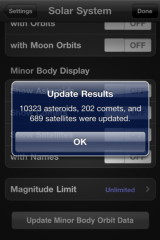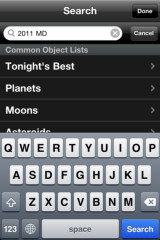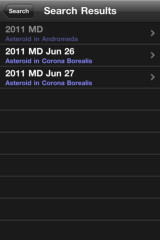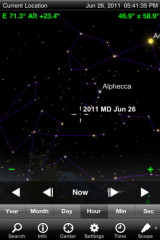As Asteroid 2011 MD Buzzes Earth, Track it on your iPhone!
One-Day App Sale Lets Users Follow Near Miss by Space Rock
SAN FRANCISCO, CA, June 26th, 2011 - On Monday, a house-sized space rock called 2011 MD will fly by the Earth, passing less than 8,000 miles from our planet's surface. Although it poses no danger of collision, it was only discovered last Wednesday, and comes unnervingly close to our southern hemisphere.
This is the fifth-closest asteroid flyby of all time, but only the first one - ever - that you can follow on your iPhone.
To do this, you'll need a copy of SkySafari 3 Plus or Pro - Southern Stars' award-winning iOS astronomy app. Southern Stars are making both apps half price (Plus - $6.99; Pro - $29.99; prices in USD) on the iTunes store on Monday, June 27th for the event.
To download SkySafari 3 Plus now, go to the iTunes store by clicking this link:
http://itunes.apple.com/us/app/skysafari-3-plus/id437111155?mt=8
To download SkySafari 3 Pro now, go to the iTunes store by clicking this link:
http://itunes.apple.com/us/app/skysafari-3-pro/id437112382?mt=8
Once you have the app, tap Settings > Solar System, then tap the Update Orbit Data button at the bottom. Wait a minute or so for the update to complete, depending on your internet connection speed.
Then Search for "2011 MD". You'll find three results. The first is the standard orbit published by the Minor Planet Center, and gives very inaccurate positions for the asteroid. For better results, Southern Stars has obtained two additional orbits for 2011 MD from noted orbital mechanics expert Bill Gray. To follow 2011 MD before the flyby, use the entry called "2011 MD Jun 26". After the flyby, use "2011 MD Jun 27". The asteroid comes so close to Earth that our planet's gravity will fling it back into space, in nearly the same direction that it came from!
After selecting the right orbit, tap the Center button to center the asteroid on your iPhone screen. Tap the Time button to bring up the time flow controls. Then run the time forward to track the asteroid's path across the sky, at one minute per step. Note: if the asteroid is below the horizon from your location, try making the horizon transparent (under Settings > Horizon & Sky.)
Closest approach happens around 1 PM EDT on Monday, June 27th. The actual event will be observable only from South Africa and parts of Antarctica, but the approach will be visible across Australia, New Zealand, southern and eastern Asia, and the western Pacific. You'll need at least an 8-inch telescope to observe the event.
For more information, see this article on Sky & Telescope's web site:
http://www.skyandtelescope.com/observing/highlights/124430479.html
For animations of the flyby, including a view of the event from the asteroid's point of view, click this link:
http://orbit.psi.edu/~tricaric/2011MD.html
About Southern Stars
Southern Stars is a world leader in mobile applications for astronomy, and has been developing planetarium software since 1993. In 2009, Southern Stars developed SkyFi, the first wireless iPhone-based solution for telescope control. That product, and the SkyVoyager iPhone app, won a MacWorld 2010 Best of Show award. Southern Stars was the also the first company to ship a Made-for-iPad serial cable for iOS devices (SkyWire). To date, Southern Stars' iPhone apps have been downloaded more than 400,000 times.
Headquartered in San Francisco, Southern Stars has more than three decades of collective experience in developing astronomical software, telescope control systems, and instrumentation.
Tim DeBenedictis
info@southernstars.com
+1 (415) 671-6251



